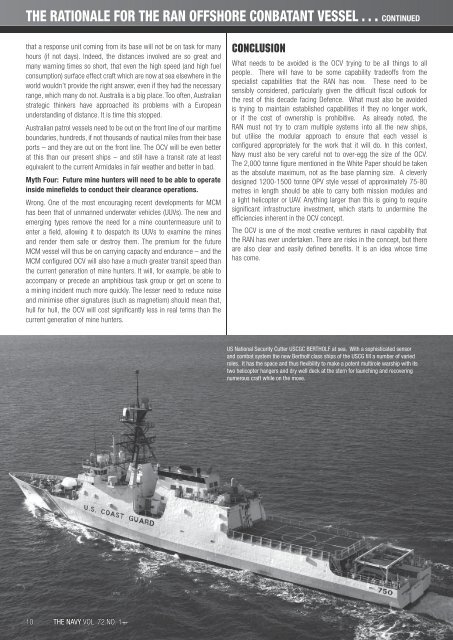JAN-MAR 2010 VOL 72 No1 - Navy League of Australia
JAN-MAR 2010 VOL 72 No1 - Navy League of Australia
JAN-MAR 2010 VOL 72 No1 - Navy League of Australia
Create successful ePaper yourself
Turn your PDF publications into a flip-book with our unique Google optimized e-Paper software.
THE RATIONALE FOR THE RAN OFFSHORE CONBATANT VESSEL . . . CONTINUED<br />
that a response unit coming from its base will not be on task for many<br />
hours (if not days). Indeed, the distances involved are so great and<br />
many warning times so short, that even the high speed (and high fuel<br />
consumption) surface effect craft which are now at sea elsewhere in the<br />
world wouldn’t provide the right answer, even if they had the necessary<br />
range, which many do not. <strong>Australia</strong> is a big place. Too <strong>of</strong>ten, <strong>Australia</strong>n<br />
strategic thinkers have approached its problems with a European<br />
understanding <strong>of</strong> distance. It is time this stopped.<br />
<strong>Australia</strong>n patrol vessels need to be out on the front line <strong>of</strong> our maritime<br />
boundaries, hundreds, if not thousands <strong>of</strong> nautical miles from their base<br />
ports – and they are out on the front line. The OCV will be even better<br />
at this than our present ships – and still have a transit rate at least<br />
equivalent to the current Armidales in fair weather and better in bad.<br />
Myth Four: Future mine hunters will need to be able to operate<br />
inside minefields to conduct their clearance operations.<br />
Wrong. One <strong>of</strong> the most encouraging recent developments for MCM<br />
has been that <strong>of</strong> unmanned underwater vehicles (UUVs). The new and<br />
emerging types remove the need for a mine countermeasure unit to<br />
enter a field, allowing it to despatch its UUVs to examine the mines<br />
and render them safe or destroy them. The premium for the future<br />
MCM vessel will thus be on carrying capacity and endurance – and the<br />
MCM configured OCV will also have a much greater transit speed than<br />
the current generation <strong>of</strong> mine hunters. It will, for example, be able to<br />
accompany or precede an amphibious task group or get on scene to<br />
a mining incident much more quickly. The lesser need to reduce noise<br />
and minimise other signatures (such as magnetism) should mean that,<br />
hull for hull, the OCV will cost significantly less in real terms than the<br />
current generation <strong>of</strong> mine hunters.<br />
CONCLUSION<br />
What needs to be avoided is the OCV trying to be all things to all<br />
people. There will have to be some capability trade<strong>of</strong>fs from the<br />
specialist capabilities that the RAN has now. These need to be<br />
sensibly considered, particularly given the difficult fiscal outlook for<br />
the rest <strong>of</strong> this decade facing Defence. What must also be avoided<br />
is trying to maintain established capabilities if they no longer work,<br />
or if the cost <strong>of</strong> ownership is prohibitive. As already noted, the<br />
RAN must not try to cram multiple systems into all the new ships,<br />
but utilise the modular approach to ensure that each vessel is<br />
configured appropriately for the work that it will do. In this context,<br />
<strong>Navy</strong> must also be very careful not to over-egg the size <strong>of</strong> the OCV.<br />
The 2,000 tonne figure mentioned in the White Paper should be taken<br />
as the absolute maximum, not as the base planning size. A cleverly<br />
designed 1200-1500 tonne OPV style vessel <strong>of</strong> approximately 75-80<br />
metres in length should be able to carry both mission modules and<br />
a light helicopter or UAV. Anything larger than this is going to require<br />
significant infrastructure investment, which starts to undermine the<br />
efficiencies inherent in the OCV concept.<br />
The OCV is one <strong>of</strong> the most creative ventures in naval capability that<br />
the RAN has ever undertaken. There are risks in the concept, but there<br />
are also clear and easily defined benefits. It is an idea whose time<br />
has come.<br />
US National Security Cutter USCGC BERTHOLF at sea. With a sophisticated sensor<br />
and combat system the new Bertholf class ships <strong>of</strong> the USCG fill a number <strong>of</strong> varied<br />
roles. It has the space and thus flexibility to make a potent multirole warship with its<br />
two helicopter hangers and dry well deck at the stern for launching and recovering<br />
numerous craft while on the move.<br />
10 THE NAVY <strong>VOL</strong>. <strong>72</strong> NO. 1

















